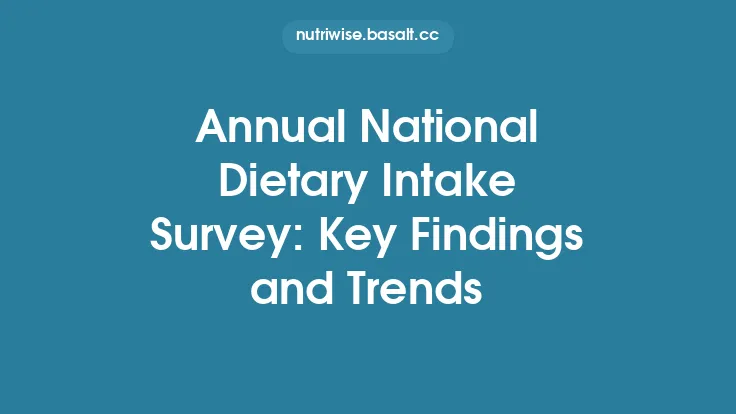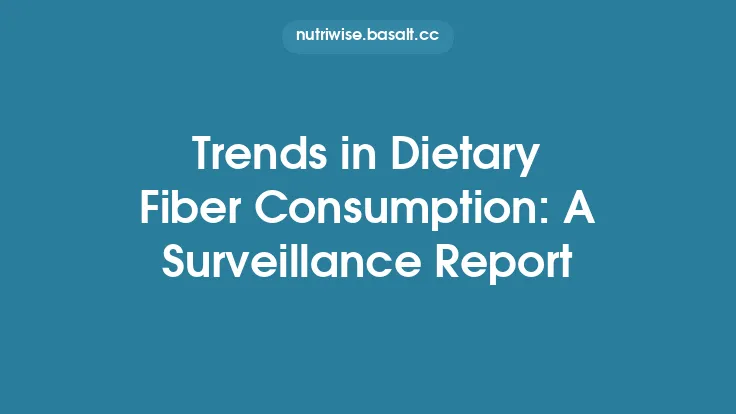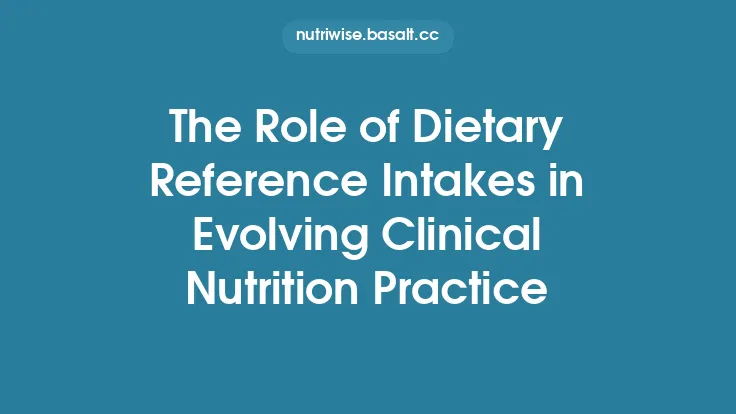Over the past several decades, dietary sodium has remained a focal point of public‑health nutrition because of its well‑established link to blood pressure regulation and subsequent cardiovascular disease (CVD) outcomes. While the physiological mechanisms connecting excess sodium to hypertension are now considered textbook knowledge, the epidemiologic landscape of sodium consumption continues to evolve. Shifts in food manufacturing practices, changes in consumer taste preferences, and the implementation of national sodium‑reduction policies have all contributed to a complex, region‑specific picture of intake trends. Understanding these trends is essential for clinicians, policymakers, and researchers who aim to mitigate the burden of CVD worldwide.
Historical Context of Sodium Consumption
The modern era of sodium epidemiology began in the mid‑20th century with the seminal work of the INTERSALT study, which demonstrated a dose‑response relationship between urinary sodium excretion and blood pressure across diverse populations. Subsequent cohort studies, such as the Framingham Heart Study and the Nurses’ Health Study, reinforced the link between high sodium intake and increased risk of coronary heart disease, stroke, and heart failure. These early investigations relied primarily on 24‑hour urinary sodium collections, establishing a gold‑standard method that remains central to contemporary surveillance.
Methods for Assessing Sodium Intake
24‑Hour Urinary Collection
The most accurate estimate of an individual’s sodium intake is derived from a complete 24‑hour urine sample, which captures approximately 90–95 % of ingested sodium. However, logistical challenges—participant burden, incomplete collections, and day‑to‑day variability—limit its feasibility for large‑scale population monitoring.
Spot Urine Samples and Predictive Equations
To address these constraints, researchers have employed spot urine specimens combined with predictive equations (e.g., Kawasaki, INTERSALT, and Tanaka formulas). While convenient, these methods introduce systematic bias, particularly in populations with extreme intake levels or varying creatinine excretion.
Dietary Recall and Food Frequency Questionnaires (FFQs)
Self‑reported dietary assessment tools can estimate sodium intake by linking reported food items to nutrient composition databases. The accuracy of this approach hinges on the completeness of sodium data in food composition tables and the respondent’s ability to recall discretionary salt use (e.g., table salt, cooking salt).
Emerging Biomarkers
Recent investigations have explored biomarkers such as plasma sodium concentration and urinary sodium‑to‑potassium ratios as proxies for intake. Although promising, these markers require further validation before routine epidemiologic use.
Global and Regional Trends in Sodium Intake
High‑Income Countries
In many high‑income nations, average sodium intake has shown modest declines over the past two decades, largely attributable to voluntary reformulation initiatives and public‑health campaigns. For example, national surveys in the United Kingdom and Finland have documented reductions of 10–15 % in mean intake, moving closer to the World Health Organization’s (WHO) recommended limit of <2 g of sodium per day (≈5 g of salt).
Middle‑Income Nations
Rapid economic development in middle‑income regions has been accompanied by increased consumption of processed and restaurant foods, which are typically high in sodium. Consequently, several countries in East Asia and the Middle East have reported rising average intakes, often exceeding 4 g of sodium per day. The lack of mandatory labeling and limited public awareness contribute to these upward trends.
Low‑Income Settings
In low‑income populations, sodium intake is heavily influenced by traditional cooking practices, such as the use of salt‑rich condiments (e.g., soy sauce, fish sauce) and preservation methods (e.g., curing, brining). While overall intake may be lower than in high‑income settings, the proportion of sodium derived from discretionary sources can be substantial, complicating reduction efforts.
Sources of Dietary Sodium
- Processed Meats and Sausages: Curing agents and flavor enhancers contribute significant sodium loads.
- Bread and Bakery Products: Even modest sodium concentrations become impactful due to high consumption volumes.
- Cheese and Dairy Products: Salt is used for texture and preservation.
- Snack Foods: Chips, pretzels, and salted nuts are common discretionary sources.
- Restaurant and Fast‑Food Meals: Portion sizes and flavor profiles often lead to high sodium content.
- Discretionary Salt: Table salt and cooking salt remain major contributors, especially in households where processed food consumption is low.
Mechanistic Pathways Linking Sodium to Cardiovascular Risk
- Blood Pressure Elevation: Sodium induces extracellular fluid expansion, increasing cardiac output and peripheral resistance. Chronic hypertension damages arterial walls, fostering atherosclerosis.
- Vascular Remodeling: High sodium intake promotes endothelial dysfunction, oxidative stress, and inflammation, accelerating arterial stiffening.
- Left Ventricular Hypertrophy: Persistent pressure overload leads to myocardial remodeling, predisposing to heart failure.
- Renal Effects: Sodium excess strains glomerular filtration, contributing to chronic kidney disease—a recognized CVD risk factor.
- Interaction with Potassium: Low dietary potassium amplifies sodium’s hypertensive effect; the sodium‑to‑potassium ratio is emerging as a stronger predictor of CVD than sodium alone.
Epidemiologic Evidence of Sodium‑Related Cardiovascular Outcomes
- Prospective Cohort Studies: Large‑scale analyses (e.g., the PURE study) have demonstrated a graded increase in CVD events with higher estimated sodium intake, even after adjusting for confounders such as age, BMI, and smoking.
- Mendelian Randomization: Genetic variants influencing sodium handling (e.g., ENaC subunit genes) have been linked to blood pressure and coronary artery disease, supporting a causal relationship.
- Meta‑Analyses of Intervention Trials: Randomized controlled trials reducing sodium intake by 1–2 g per day have consistently shown modest reductions in systolic blood pressure (≈2–4 mm Hg) and, in longer follow‑up, lower incidence of stroke.
Population Subgroups of Interest
- Older Adults: Age‑related declines in renal sodium excretion increase susceptibility to hypertension; sodium reduction yields larger blood‑pressure benefits.
- Individuals with Hypertension: Sodium restriction is a cornerstone of non‑pharmacologic management, often synergizing with antihypertensive agents.
- People with Chronic Kidney Disease: Sodium restriction slows progression of renal dysfunction and reduces cardiovascular events.
- Ethnic Minorities: Certain groups (e.g., African‑descended populations) exhibit heightened salt sensitivity, necessitating tailored public‑health messages.
Policy Interventions and Their Impact
Mandatory Sodium Targets
Countries that have instituted legally binding sodium limits for specific food categories (e.g., bread, processed meats) have observed more pronounced reductions in population intake compared with voluntary approaches.
Front‑of‑Package Labeling
Interpretive labeling schemes (e.g., “high‑salt” warnings) improve consumer awareness and can shift purchasing behavior, especially when combined with public education campaigns.
Public‑Education Campaigns
Mass‑media initiatives that promote “salt‑smart” cooking practices—such as using herbs, spices, and reduced‑sodium sauces—have demonstrated modest but measurable declines in discretionary salt use.
Institutional Procurement Policies
Setting sodium standards for school meals, workplace cafeterias, and government‑run facilities creates a controlled environment that can drive broader market reformulation.
Challenges in Sodium Reduction Efforts
- Taste Adaptation: Consumers accustomed to high‑salt foods may initially reject lower‑sodium alternatives; gradual reduction strategies are essential.
- Industry Resistance: Reformulating products without compromising safety and shelf life can be technically demanding and costly.
- Data Gaps: In many regions, up‑to‑date food composition tables lack precise sodium values, hindering accurate surveillance.
- Equity Concerns: Low‑income groups may rely on inexpensive, high‑sodium foods; policies must ensure affordable, healthier options are available.
Future Directions for Research and Surveillance
- Standardized Monitoring Protocols: Harmonizing urinary collection methods across studies will improve comparability of trend data.
- Integration of Sodium‑to‑Potassium Ratios: Evaluating the combined effect of these electrolytes may refine risk prediction models.
- Precision Nutrition Approaches: Identifying genetic and phenotypic markers of salt sensitivity could enable individualized dietary recommendations.
- Longitudinal Cohort Expansion: Extending follow‑up periods in existing cohorts will clarify the long‑term cardiovascular benefits of sustained sodium reduction.
- Implementation Science: Investigating the real‑world effectiveness of policy interventions, including cost‑effectiveness analyses, will guide resource allocation.
Concluding Perspective
The epidemiology of dietary sodium intake is characterized by both progress and persistent challenges. While high‑income nations have begun to reverse historical upward trends through coordinated policy and public‑health actions, many middle‑ and low‑income regions continue to experience rising sodium consumption driven by dietary transitions. Robust, methodologically sound surveillance—anchored in accurate urinary measurements and complemented by refined dietary assessment tools—is indispensable for tracking these trends.
Crucially, the link between sodium intake and cardiovascular risk remains biologically plausible and empirically supported across diverse populations. Continued investment in sodium‑reduction strategies, tailored to cultural contexts and socioeconomic realities, offers a high‑impact avenue for curbing hypertension and its downstream cardiovascular sequelae. By aligning scientific insight with pragmatic policy, the nutrition research community can sustain momentum toward a future where average sodium consumption aligns with global health recommendations, thereby reducing the global burden of cardiovascular disease.




